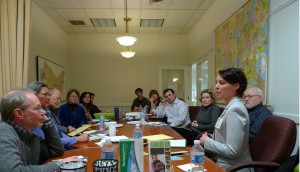
Solar panels are just one of many possible investments that can save businesses money in the futur
Business owners, when confronted with the decision of moving towards more sustainable practices, are sometimes weary of giving such an idea the green light. For owners, almost every decision is made with the bottom line in mind; a business that does not earn profit simply will not survive. The potential for high up front costs is enough for many owners to say “no thanks” and stick with the same practices that have been in use for years. Owners may think, “If a company is making a profit, why change anything?”
Well, when looking at a switch to sustainable business practices as an investment rather than a cost, the decision can be a lot more beneficial to the bottom line than one would think. This is exactly how L. Hunter Lovins presents the switch to sustainable practices for businesses. She recently sat down with The New York Times to talk about the non profit Natural Capitalism Solutions of which she is president. In order to promote sustainability, the company provides “innovative, practical tools and implementation strategies for companies, communities, and countries”.
NCS’s strategy is to present the switch to sustainability as an investment, and focuses on finding the areas of a business that can be more efficient, thus effecting the bottom line in a positive way. It is important to show that there can and will be a return on the investment, not just a large up front cost. For example NCS worked with Scandic Springs, a metal manufacturer in California. The company made a small change in the amount of cardboard used in their packaging, saving them $8,000 a year. While they paid very little to make this happen, other investments in sustainability can cost a lot more up front, so it takes more to convince some businesses.
Lovins says that they stay away from presenting any arguments about climate change or global warming, and choosing instead to stick to the economic benefits. This way, business owners who may not believe in global warming can still be swayed to make changes towards greener practices. It has become another way to help solve climate change without actually talking about climate change. In fact, according to Lovins, it is easier to convince those who are skeptical or may not know much about climate change, rather than those who consider themselves believers.
With their success working with businesses, NCS is able to show interested companies the progress of others who have worked with them to help find a place to start. Even small businesses can start changing towards more efficient practices and get a quick return. According to Lovins, one of the quickest returns is efficient lighting by switching to compact fluorescents from old fluorescents or incandescent bulbs.
Lovins also stresses the importance of following trends in your area. Local, state and federal laws regarding energy efficiency are changing, so it is important to stay ahead and be prepared to make changes to comply with new efficiency codes. Also, keep up (or better yet, ahead) of competition. On top of the savings from sustainability, there may also be a competitive advantage especially if a business is in a community where it’s important to residents that companies do good within the community.
Today, energy efficiency and sustainability are more than just fashionable trends. They are good business. More and more local small businesses are doing it, and even large worldwide corporations are making green changes. As Lovins said, “Why is Wal-Mart going green? Trust me, it’s not out of the goodness of their heart. They are going green because they are saving money.”









